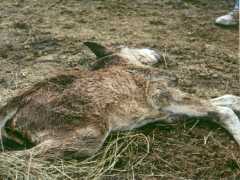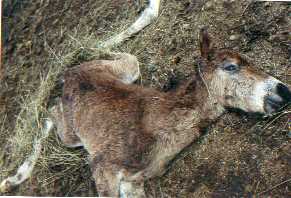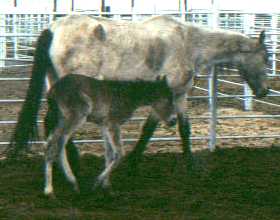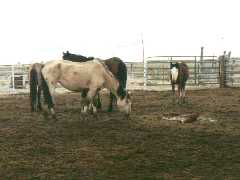|
Every Horse has a Story
I grew up a Shoshone Indian horse, as did my dam before me and the dams before her. We've been on this range for 150 years, passed down from Shoshone grandfather grandmother to Shoshone grandson and granddaughter. Life wasn't always easy but we survived off this land, living in our family bands, eating the grass and walking to the watering holes each day. But in the past year everything changed. For reasons we could not comprehend, we were declared trespassers on the very lands where we roamed free for generations. Most of our bands were rounded up. Horses I knew all my life were herded into trucks and hauled away. I was pregnant, as were about 150 other mares, and I was in no condition to travel. We were all taken to a place called Fish Creek where there was hardly any grass and poor water. For many days we stood with little food or clean water. At least one mare died. She was so hungry she ate wooden fences, small rocks, anything she could find. She lay down and struggled with a terrible pain in her belly. Finally she became quiet and some men dragged her away. Some big round rolls of food were brought in for us but it was pretty much just mowed range grass. The stronger mares crowded in to eat it but it didn't help us a whole lot. Then the other mares began to have their foals. Some foals never got up after being born. Other foals did get up but got very weak. Some of weak ones eventually laid quietly, never to move again, and were taken away by some men.
I stood watch over her until some people came, wrapped her in a blanket and carried her out. I followed them to the gate, calling out for my foal but she never answered and I never saw her again. I still stand in this place, feeling weak and watching the other mares struggle with their foals. And I see other foals that never get up and get carried away. How did we get here? Why did we get here? What good can come from all of this? | |

|

|
|
The buckskin mare and 143 other mares plus some foals were originally signed over to Slick Gardner of California. Gardner transported a number of other horses to California where they appear to be improving in their condition.
For reasons we have yet to fully understand but which are being investigated, these mares were not adequately cared for. Lifesavers Wild Horse Rescue of Lancaster, CA, has taken the necessary steps to assume legal responsibility for these horses and to be financially responsible for their recovery and relocation. Least Resistance Training Concepts (LRTC) has taken on the task of handling the logistics for this effort; seeing that the animals get proper food, water and care and that certain other obligations are met. A number of other California and Nevada wild horse groups pitched in to help and the complete story of this rescue can be viewed here.
Return to Fish Creek Horse ReportReturn to KBR Wild Horse & Burro NewsReturn to KBR World of Wild Horses & Burros | |
 The Buckskin Mare
The Buckskin Mare
 I, too, had a foal, a sweet filly with a fawn colored coat that so many young horses have out here. But I was weak. I didn't have enough milk and my foal got weaker each day. Eventually, like some of the others I saw, she couldn't get up any more. I nuzzled her and licked her and I even brought her a mouthful of food from the big round bale but she just lay there.
I, too, had a foal, a sweet filly with a fawn colored coat that so many young horses have out here. But I was weak. I didn't have enough milk and my foal got weaker each day. Eventually, like some of the others I saw, she couldn't get up any more. I nuzzled her and licked her and I even brought her a mouthful of food from the big round bale but she just lay there.